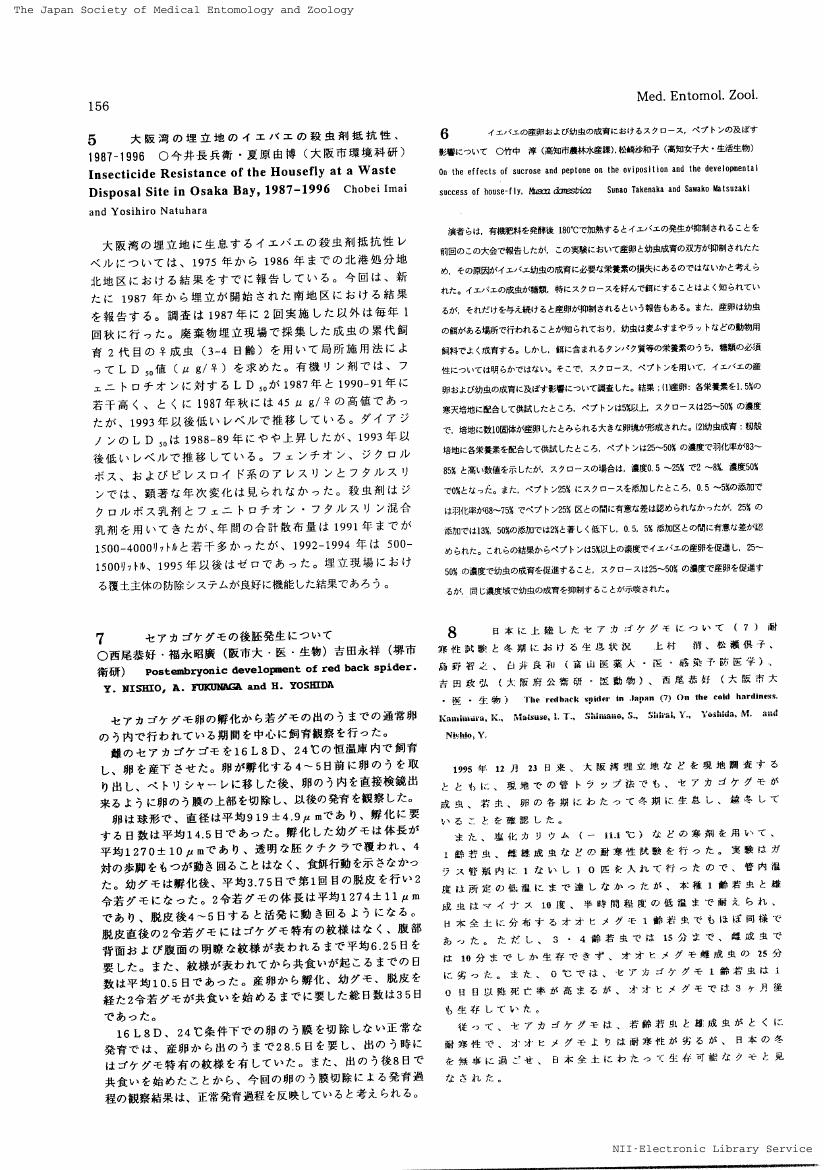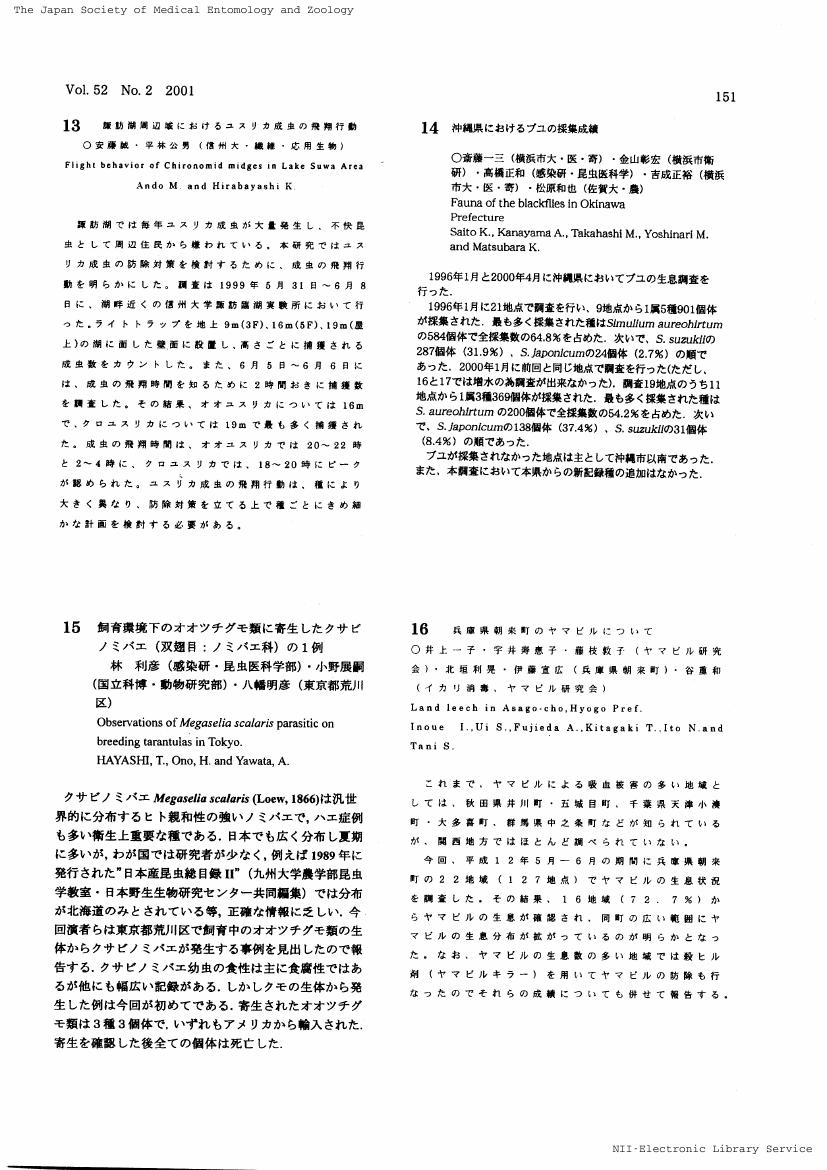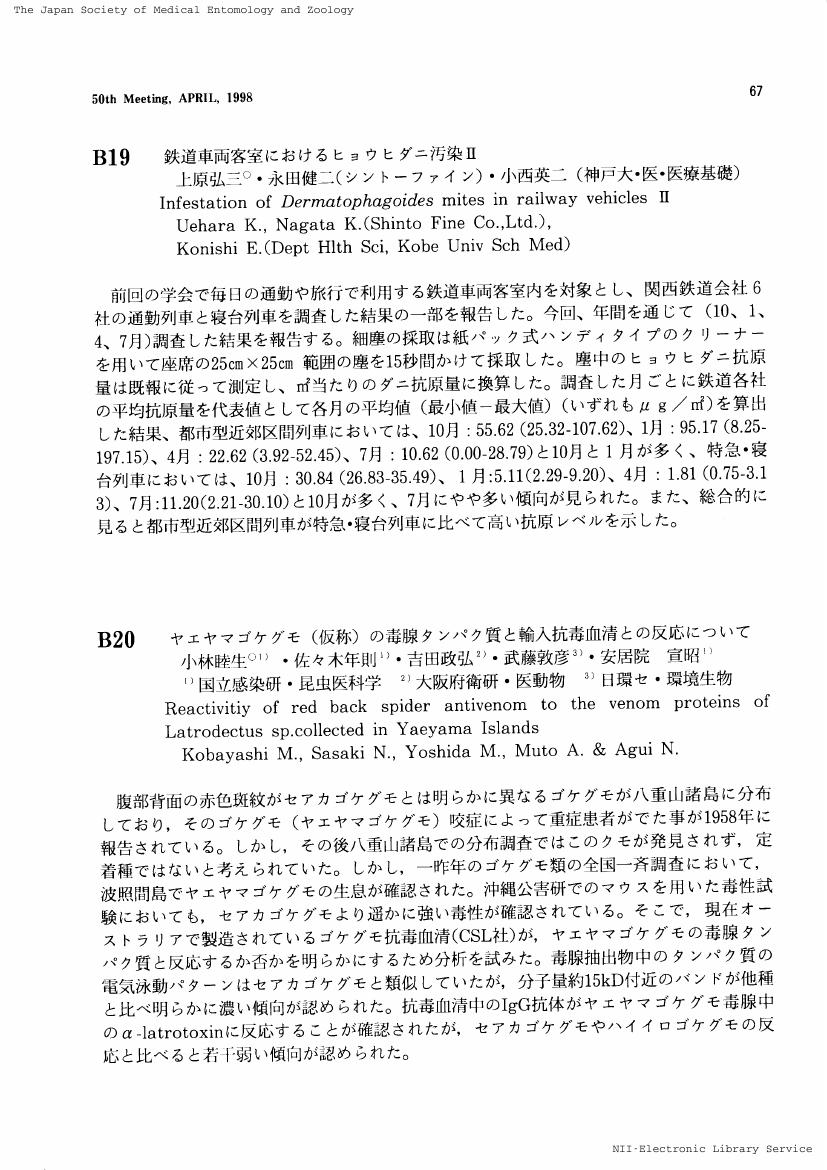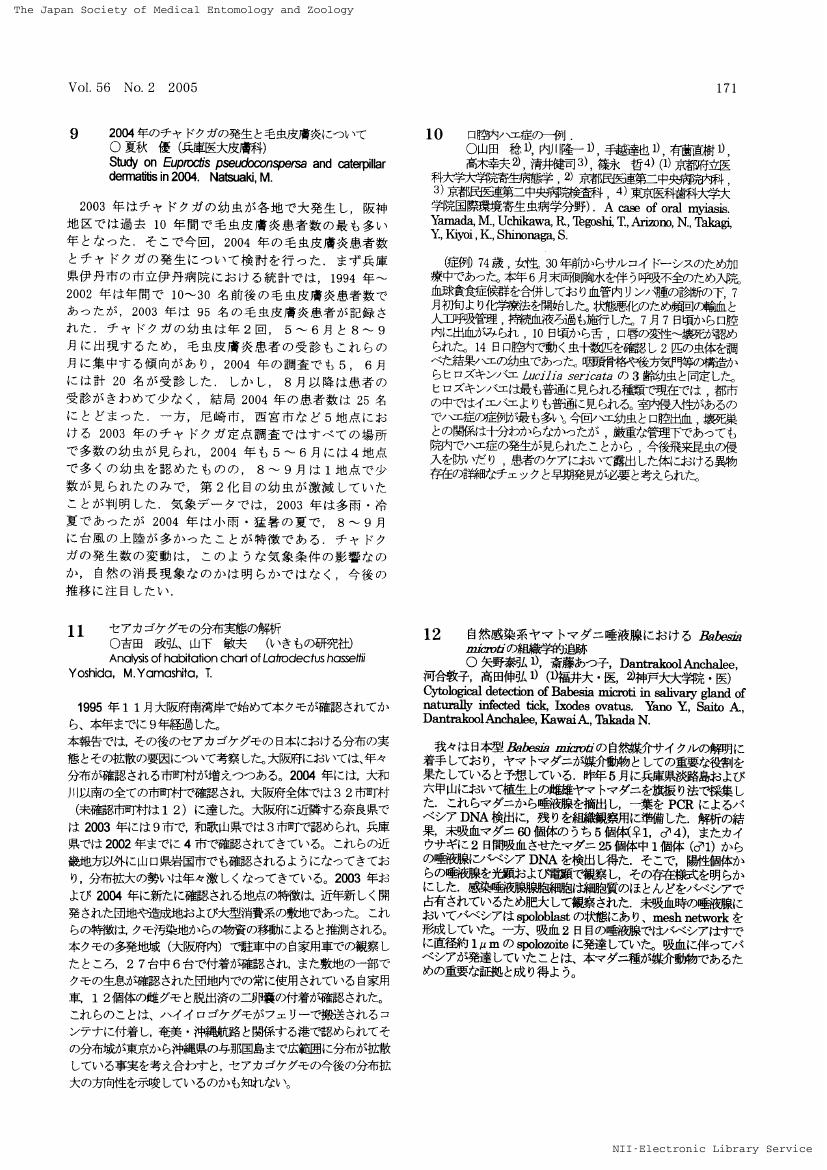1 0 0 0 OA 日本に侵入したセアカゴケグモの低温適応性
- 著者
- 松瀬 イネス倶子 武田 カチア美知枝 上村 清 吉田 政弘
- 出版者
- The Japan Society of Medical Entomology and Zoology
- 雑誌
- 衛生動物 (ISSN:04247086)
- 巻号頁・発行日
- vol.48, no.2, pp.117-122, 1997-06-15 (Released:2016-08-20)
- 参考文献数
- 6
- 被引用文献数
- 7 8
セアカゴケグモは1995年9月に大阪府の高石市で発見され, 大阪湾沿岸地帯, 三重県四日市市などでも生息が確認された。また1996年3月上旬の現地調査ではセアカゴケグモの越冬が確認され, 春夏秋冬のいずれの調査において成成虫, 若虫, 卵嚢のいずれもが採集できた。採集したクモと卵嚢は研究室に持ち帰り, 25℃, 60% RH, 14時間照明で, 50ml容量のガラス瓶内で, ショウジョウバエを餌とし, 個別飼育を行った。その内, 卵嚢より脱出した若虫を用いて, セアカゴケグモが寒冷期に, 冬期と同様の低温条件下の飼育によって生存できるかどうかを検討した。その結果, 5℃においては最長47日間生存し, 10℃及び15℃ではそれぞれ175及び270日生存した。この間の発育零点は15℃前後であった。セアカゴケグモを含むゴケグモ類が日本に分布していなかった主因は気温によるものと推定されているが, 飼育実験の結果, セアカゴケグモは日本に定着し, さらにより広範囲に広がる可能性があることが示唆された。
1 0 0 0 OA 7 セアカゴケグモの後胚発生について
1 0 0 0 OA 8 日本に上陸したセアカゴケグモについて (7) 耐寒性試験と冬期における生息状況
1 0 0 0 OA 9.セアカゴケグモの分散様式(58回日本衛生動物学会西日本支部大会講演要旨)
- 著者
- 吉田 政弘
- 出版者
- 日本衛生動物学会
- 雑誌
- 衛生動物 (ISSN:04247086)
- 巻号頁・発行日
- vol.55, no.2, pp.148, 2004-06-15 (Released:2016-08-07)
1 0 0 0 OA 11 ハイイロゴケグモの 1 産卵期における産卵数
- 著者
- 稲田 貴嗣
- 出版者
- 日本衛生動物学会
- 雑誌
- 衛生動物 (ISSN:04247086)
- 巻号頁・発行日
- vol.49, no.2, pp.148, 1998-06-15 (Released:2016-08-18)
1 0 0 0 OA EB16 セアカゴケグモの分布
- 著者
- 吉田 政弘
- 出版者
- 日本衛生動物学会
- 雑誌
- 衛生動物 (ISSN:04247086)
- 巻号頁・発行日
- vol.52, no.Supplement, pp.143, 2001-04-04 (Released:2016-08-09)
- 著者
- 吉田 政弘
- 出版者
- 日本衛生動物学会
- 雑誌
- 衛生動物 (ISSN:04247086)
- 巻号頁・発行日
- vol.59, no.2, pp.114, 2008-06-15 (Released:2016-08-06)
1 0 0 0 OA わが国の有毒蜘蛛, カバキコマチグモ Chiracanthium japonicum Bosenberg et Strand, 1906 の病害と生態に関する研究 : 2. カバキコマチグモの生態
- 著者
- 大利 昌久
- 出版者
- 日本衛生動物学会
- 雑誌
- 衛生動物 (ISSN:04247086)
- 巻号頁・発行日
- vol.27, no.2, pp.181-188, 1976-04-15 (Released:2016-09-05)
- 被引用文献数
- 3 2
Chiracanthium japonicum is well known as a poisonous spider. The geographical distribution of the spider was studied in various localities in Japan during the period from 1959 to 1975. This spider was recognized to distribute widely in Japan. From the study on the vertical distribution at Mt. Kyoga located on the Nagasaki-Saga prefectural border, Kyushu, South Japan, they were found widely over various heights, though they were most abundant in the zone from 200 to 300m in height. Ecological field study was made on the seasonal change and habitats at the mountain of Shironokoshi in Nagasaki Prefecture during the period from March to September in 1967. The total number of 1331 spiders, which consisted of 577 male and 754 female spiders, was recorded from the survey areas. They were distributed mostly in bush, especially in Gramineae groups during the period from May to July. The laboratory observation was made on their behavior, especially on mating, breeding and hatching. Among them, it was the most dramatic behavior that the spiderlings caught and killed their mother after the second molting. The parasitic insect which was observed on the back of this spider was identified as Homonotusiwatai Yasumatsu (Hymenoptera; Pompilidae). The best method for eliminating this species to prevent arachnidism is by means of the weeding of the grass belonging to the family Gramineae at areas close to houses in April before the final molting of male spiders. Children must be taught that this spider is dangerous, because they are more often bitten than adults.
1 0 0 0 OA 各種殺虫剤のセアカゴケグモ Latrodectus hasseltii に対する殺虫効力
- 著者
- 永田 健二 新庄 五朗 奥田 寿男 吉田 政弘
- 出版者
- 日本衛生動物学会
- 雑誌
- 衛生動物 (ISSN:04247086)
- 巻号頁・発行日
- vol.48, no.2, pp.135-139, 1997-06-15 (Released:2016-08-20)
- 参考文献数
- 6
- 被引用文献数
- 1 3
Lethal and knockdown effects of several insecticides to red-back widow spiders, Latrodectus hasseltii, were evaluated. Spiders were collected three times in Osaka and Mie Prefectures, Japan, in 1995 and 1996. In the continuous contact method on glass pot and the topical application method, permethrin and phenothrin were most effective among the tested insecticides. Knockdown and lethal effects by spraying with commercial insecticide aerosols, containing pyrethroids, were sufficient in the case of direct spraying without the web, but the effects decreased in the case of spraying through the web.
1 0 0 0 OA B20 ヤエヤマゴケグモ (仮称) の毒腺タンパク質と輸入抗毒血清との反応について
1 0 0 0 OA 51 セアカゴケグモの分布(2003年)
- 著者
- 吉田 政弘
- 出版者
- 日本衛生動物学会
- 雑誌
- 衛生動物 (ISSN:04247086)
- 巻号頁・発行日
- vol.55, no.Supplement, pp.57, 2004-04-01 (Released:2016-08-07)
1 0 0 0 OA 衛生害虫の天敵としてのクモ類の研究 : 3. オオヒメグモの生態
- 著者
- 大利 昌久
- 出版者
- 日本衛生動物学会
- 雑誌
- 衛生動物 (ISSN:04247086)
- 巻号頁・発行日
- vol.26, no.1, pp.15-19, 1975-05-15 (Released:2016-09-05)
- 被引用文献数
- 2 4
A study was made on the distribution and population density of the spider, Theridion tepidariorum, which is well known as one of the natural enemies of pest insects, in various localities in Nagasaki Prefecture in 1966. The number of T. tepidariorum was observed over eight different kinds of environment : forests, paddy field, farms, caves, sewers, houses (urban and suburban) and cattle barns. Their population density was highest at the inside of animal sheds and houses, in which this spider was found abandantly in the barn, kitchen and latrine. The seasonal prevalene in the house and the breeding season in three stations were also surveyed throughout a year. The peak of the population density in the house was observed in June and July. Many egg-sacs were layed in the warm season from May to August with a marked peak in June and a few in the rest seasons. The mean frequency of oviposition per female in a whole life was 3.08 and the mean number of eggs per egg-sac was 347.1. The preys of this species were insect species belonging to the orders Blattaria, Dermaptera, Isoptera, Hemiptera, Mecoptera, Lepidoptera, Coleoptera, Hymenoptera and Diptera, Among them, many of the flies, chironomids (Diptera) and Blattaria were trapped by the web more frequently than any other insects.
- 著者
- 木船 悌嗣
- 出版者
- 日本衛生動物学会
- 雑誌
- 衛生動物 (ISSN:04247086)
- 巻号頁・発行日
- vol.46, no.1, pp.18, 1995-03-15 (Released:2016-08-23)
- 被引用文献数
- 1
1 0 0 0 OA 衛生動物毒素研究最近の進歩 : クモ、サソリ、ハチ、クラゲ毒など
- 著者
- 中嶋 暉躬
- 出版者
- 日本衛生動物学会
- 雑誌
- 衛生動物 (ISSN:04247086)
- 巻号頁・発行日
- vol.53, no.Supplement, pp.22, 2002-04-01 (Released:2016-08-07)
1 0 0 0 OA 11 セアカゴケグモの分布実態の解析(第59回日本衛生動物学会西日本支部大会講演要旨)
- 著者
- 吉田 政弘 山下 敏夫
- 出版者
- 日本衛生動物学会
- 雑誌
- 衛生動物 (ISSN:04247086)
- 巻号頁・発行日
- vol.56, no.2, pp.171, 2005-06-15 (Released:2016-08-07)
1 0 0 0 OA 2 日本における毒グモの分布と今後の動向(第2回日本衛生動物学会西日本支部例会講演要旨)
- 著者
- 吉田 政弘
- 出版者
- 日本衛生動物学会
- 雑誌
- 衛生動物 (ISSN:04247086)
- 巻号頁・発行日
- vol.59, no.2, pp.129-130, 2008-06-15 (Released:2016-08-06)















